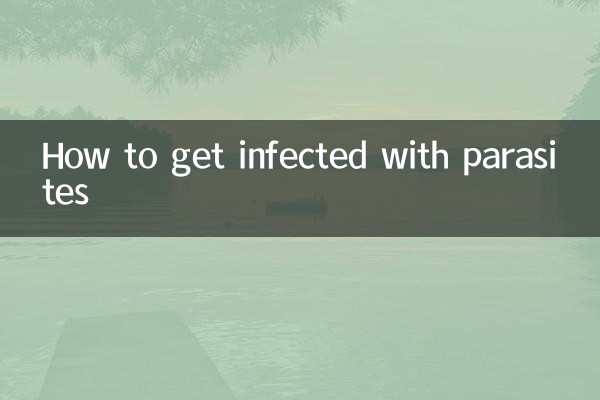How to get infected with parasites
Parasitic infections are a global health problem that may be spread through a variety of pathways. In recent years, with increased food safety, sanitation conditions, and international travel, the topic of parasitic infections has become a hot topic again. This article will combine the hot topics and hot content on the Internet in the past 10 days to analyze the common pathways, symptoms and preventive measures of parasitic infections, and provide structured data to help readers better understand this issue.
1. Common routes of parasitic infection

Parasites can enter the human body in a variety of ways, including the following:
| route of infection | Specific methods | Common parasites |
|---|---|---|
| food contamination | Eating undercooked meat, seafood, or raw vegetables | Tapeworm, Toxoplasma gondii, roundworm |
| water pollution | Drinking or coming into contact with contaminated water | Giardia, amoeba |
| contact spread | Direct contact with infected animals or soil | Hookworms, scabies mites |
| insect bites | Transmitted by mosquitoes, ticks and other vectors | Plasmodium, filarial parasites |
2. Common symptoms of parasitic infections
Symptoms of a parasitic infection vary depending on the species of parasite and the site of infection. Here are some common symptoms:
| Symptom type | Specific performance | Possibly related parasites |
|---|---|---|
| digestive symptoms | Abdominal pain, diarrhea, nausea, vomiting | Roundworms, tapeworms, giardia |
| skin symptoms | Itching, rash, ulcers | Scabies mites, hookworms |
| systemic symptoms | Fever, fatigue, weight loss | Plasmodium, Toxoplasma gondii |
| neurological symptoms | Headache, convulsions, disturbance of consciousness | Cysticerci, Toxoplasma gondii |
3. Recent hot topics and parasitic infections
According to the hot content on the Internet in the past 10 days, the following topics are closely related to parasitic infections:
| hot topics | Main content | Related parasites |
|---|---|---|
| Raw food risks | Raw foods such as sashimi and raw beef may carry parasites | Tapeworm, Toxoplasma gondii |
| pet spread | Pets such as cats and dogs may transmit parasites to humans | Toxoplasma gondii, hookworm |
| travel health | When traveling to tropical areas, be aware of the risk of parasitic infections | Plasmodium, Schistosoma |
| Water safety | Drinking water sources in some areas may be contaminated by parasites | Giardia, amoeba |
4. How to prevent parasitic infections
The key to preventing parasitic infections is to practice good hygiene and pay attention to food safety:
| Precautions | Specific methods | Types of parasites targeted |
|---|---|---|
| food safety | Cook meat and seafood thoroughly and avoid eating them raw | Tapeworm, Toxoplasma gondii |
| Drinking water safety | Drink boiled or filtered water | Giardia, amoeba |
| personal hygiene | Wash your hands frequently and avoid contact with contaminated soil | Hookworms, roundworms |
| pet management | Deworm your pets regularly and avoid contact with pet feces | Toxoplasma gondii, hookworm |
| Pest control measures | Use anti-mosquito products to avoid insect bites | Plasmodium, filarial parasites |
5. Summary
Parasitic infection is a health problem that requires great attention, especially in recent years, with changes in dietary habits and lifestyles, the risk of infection has increased. By understanding the routes of infection, symptoms and prevention measures, we can better protect ourselves and our families. If you suspect that you may be infected with parasites, you should seek medical advice promptly and have relevant tests done.
It is worth noting that the diagnosis and treatment of parasitic infections require the guidance of a professional doctor and do not self-medicate. At the same time, maintaining good hygiene habits and food safety awareness are the most effective ways to prevent parasitic infections.

check the details

check the details